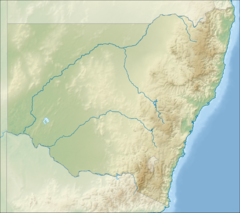Marramarra National Park
| Marramarra National Park | ||
|---|---|---|
|
|
||
| Location: | New South Wales , Australia | |
| Specialty: | Wooded sandstone plateau with narrow canyons | |
| Next city: | Wisemans Ferry, Lower Hawkesbury | |
| Surface: | 118 km² | |
| Founding: | December 28, 1979 | |
The Marramarra National Park is a national park in eastern Australian state of New South Wales , 41 kilometers north of Sydney . It lies on the south bank of the Hawkesbury River , which borders the park to the north and east. To the north, on the other bank of the river, is Dharug National Park , and to the east is Ku-ring-gai-Chase National Park .
geology
The park consists of a flat sandstone plateau , the southwestern part of the Hornsby Plateau , into which the Hawkesbury River and its tributaries, the Berowra Creek , the Marramarra Creek and the Coba Creek have cut deep.
history
The Aboriginesstämme the Dharug and the Ku-ring-gai populated formerly the area of today's park. Only 30 years after the arrival of the European settlers with the First Fleet in 1787, however, the Ku-ring-gai were practically exterminated.
In 1789, Governor Arthur Phillip began exploring this area on his second expedition up the Hawkesbury River. Gentleman's stop is said to have been the last camp on the expedition. Later it became a small settlement on the river as a base for the supply of the colonies on the Hawkesbury River and the Macdonald River . In 1884 the settlement got its own provisional school. Today you can only see remnants of the road and the pier of the settlement.
Traces of white settlement can also be found in other places in the park, for example the remains of fruit plantations on Marramarra Creek.
On December 28, 1979, the area was elevated to a national park.
flora
The vegetation on the hills, plateaus and arid slopes is typical of Hawkesbury sandstone areas. You can find forests with different types of eucalyptus , such as the Red Bloodwood , the Scribbly Gum and the Sydney Red Gum . On the drier locations there are bushland and dwarf apple trees . The Sydney Peppermint , the Sydney Red Gum , the Blackbutt and the Turpentine , all species of eucalyptus, grow in the deep valleys and on the protected east and south slopes . There are also places with temperate rainforest in the deep stream valleys .
fauna
Swamp wallabies , Stuart broad-footed pouches , bush rats , various possum species , echins , kookaburras , black- headed black cockatoos , short-headed gliding pouches , feather-tail gliding pouches , nasal sacs , platypus , lyre tails and white-bellied eagles live in the park . Particularly noteworthy are the endangered species, such as koalas , giant pouch martens , as well as various frog (e.g. Giant Burrowing Frog ) and owl species (e.g. Powerful Owl , Sooty Owl ).
